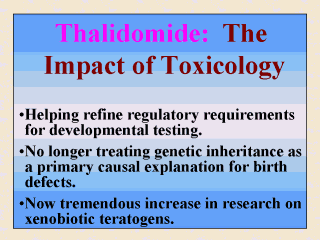| front |1 |2 |3 |4 |5 |6 |7 |8 |9 |10 |11 |12 |13 |14 |15 |16 |17 |18 |19 |20 |21 |review |
 |
The thalidomide
tragedy, together with the teratogenicity studies in animals, has helped refine the
regulatory requirements for developmental testing. One of the most important documents
concerning these issues was (and still is) the Guidelines for Reproductive Studies for
Safety Evaluation of Drugs for Human Use, that published by the U.S. Food and Drug
Administration in 1966 (five years after thalidomide was proven as a notorious human
teratogen). Regulatory agencies in many other countries have also developed testing requirements for evaluating the effects of drugs on pregnancy outcomes that are separate from chronic toxicity studies. In the USA, the concerns over these issues eventually led to the development of Segment I, II, and III testing protocols for reproductive and developmental toxicity studies. As pointed out by Manson and Wise (1991), after the recognition of species differences in response and sensitivity, “The emphasis in the field of teratology shifted from genetic inheritance as a primary causal explanation for birth defects to xenobiotic exposures during pregnancy. There has been tremendous increase in research on xenobiotic teratogens since the thalidomide tragedy, much of which has been influenced by the characteristic and unique events associated with the human response to this drug.” |